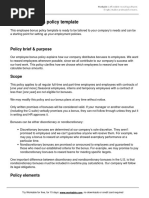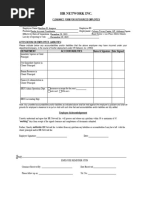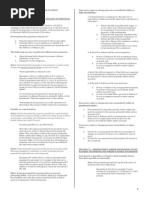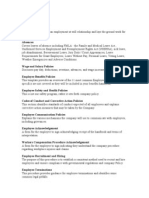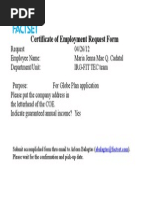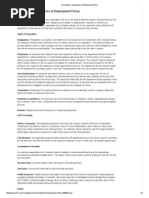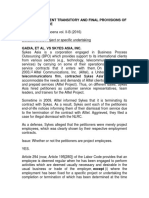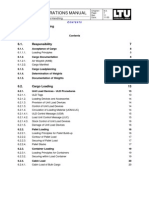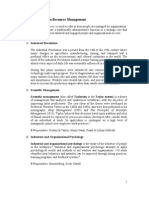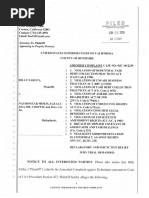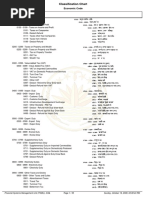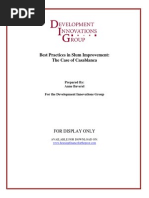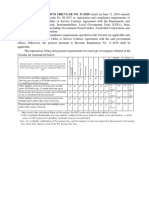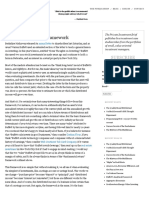Leaves of Absence Policies
Leaves of Absence Policies
Uploaded by
Akash ThebossCopyright:
Available Formats
Leaves of Absence Policies
Leaves of Absence Policies
Uploaded by
Akash ThebossCopyright
Available Formats
Share this document
Did you find this document useful?
Is this content inappropriate?
Copyright:
Available Formats
Leaves of Absence Policies
Leaves of Absence Policies
Uploaded by
Akash ThebossCopyright:
Available Formats
ACTUAL POLICIES ARE MICROSOFT WORD FORMAT & ARE FULLY CUSTOMIZABLE
SUBJECT: Leaves Of Absence PURPOSE: To provide a standard policy for administering and granting employee leaves of absence. POLICY: It is the policy of Employer ABC to grant leaves to all employees on a consistent basis without regard to race, color, national origin, sex, religion, age, disability or veteran status. CONTENTS: 1. Vacation Leave 2. Sick Leave 3. Bereavement Leave 4. Emergency Leave 5. Military Leave 6. Jury Duty Leave 7. Federal Family & Medical Leave Act (FMLA) and Parental Leave 8. Leave Without Pay 9. Administrative Leave for Outstanding Performance 10. Employee and Department Responsibilities for Leave 1. Vacation Leave Employees shall be entitled to a paid vacation in each fiscal year. Part-time employees will accrue vacation leave on a pro-rated basis with a pro-rated maximum carryover. Entitlement is earned in accordance with the following schedule based on full-time employment: Length Of Employment 0 but less than 2 years 2 but less than 5 years 5 but less than 10 years 10 but less than 15 years 15 but less than 20 years 20 years and over Hours Accrued Each Month 7 8 9 10 11 14 Carryover to Next Fiscal year 168 232 256 280 328 376
Vacation entitlement will begin on the first day of employment and terminate on the last day of employment based on the above chart. Based on the above chart, any unused leave time will be carried over each fiscal year. Unused accumulated vacation that exceeds the maximum carryover will be credited to the employee's sick leave balance the first day of the next fiscal year. Credit for one month's accrual is given for each month (or fraction of a month) of employment and on the first of each succeeding month thereafter. Note: An employee cannot use vacation leave credits until he/she returns to work. Credit for a higher accrual rate is given on the first calendar day of the month, if the employee's anniversary date falls on the first calendar day of the month. Otherwise, the increase occurs on the first calendar day of the following month. Note: the first WORKDAY of a month = the first CALENDAR day of the month for the purpose of this subsection. Vacation with pay may not be granted until the employee has had continuous employment for six (6) months, although credit will be accrued during that period. Employees may take unearned vacation leave or borrow against future accruals. Employees are encouraged to take vacation in the fiscal year in which the entitlement is earned. The employee should schedule vacation leave in advance at a mutually agreeable time to both the employee and supervisor.
ACTUAL POLICIES ARE MICROSOFT WORD FORMAT & ARE FULLY CUSTOMIZABLE
ACTUAL POLICIES ARE MICROSOFT WORD FORMAT & ARE FULLY CUSTOMIZABLE
In computing vacation time taken, time during which an employee is excused from work because of holidays shall not be charged against the employee's vacation. Vacation accruals will be used for absences due to illness after all accumulated sick leave and compensatory time has been exhausted. If as a condition of employment you accept or transfer to a position not eligible for vacation accrual, your current vacation balance will be vested and compensated at the final rate of compensation in the last position held that accrued vacation time. Employees are not eligible to use accrued vacation time while in a position not eligible for vacation accrual. An employee who resigns or separates from employment (including death) will be paid all their unused balance of vacation at the time of separation. Vacation pay out will be the nearest payday after the date of separation.
2. Sick Leave Employees earn sick leave on the first day of employment and terminating on the last day of duty. Credit for one month's accrual will be given for each month or fraction of a month of employment. Sick Leave is earned at the rate of eight (8) hours for each month or fraction of a month employment, and accumulates with unused such leave carried forward each month. Part-time employees accrue on a pro-rated basis. Sick leave accrual terminates on last day of employment. Sick leave is taken when sickness, injury, or pregnancy and confinement prevent the employee to perform job duties or when the employee is needed to care for a member of their immediate family who is ill. (1) Immediate family is defined as individuals who reside in the same household and are related by kinship, adoption, or marriage, as well as certified foster children. (2) Minor children of the employee, whether or not living in the same household, are considered immediate family. (3) An employee's use of sick leave for family members not residing in that employee's household is strictly limited to the time necessary to provide care to a spouse, child, or parent of the employee. This provision does not include an employee's parent-in-law if they do not live in the same household. An employee absent from work due to illness must notify their supervisor or cause them to be notified of that fact as soon as possible. To be eligible for accumulated sick leave with pay during a continuous period of more than four (4) working days (includes partial absences), an employee must send a doctor's certificate showing the cause or nature of the illness to the supervisor. Note: A written statement of the facts concerning the illness is also acceptable. The supervisor has the discretion to require this documentation. Abuses of sick leave privileges shall constitute grounds for dismissal from employment. For employees returning to work as a retiree accrues sick leave as a new employee. Illnesses of the same type or that may routinely re-occur, will have a lifetime maximum sick leave use of ninety (90) days. Employees must advise their supervisor if they are in receipt of subrogation benefits, i.e., by legal right collecting pay, reimbursement for loss of work time, or damages from a third party.
3. Bereavement Leave
ACTUAL POLICIES ARE MICROSOFT WORD FORMAT & ARE FULLY CUSTOMIZABLE
ACTUAL POLICIES ARE MICROSOFT WORD FORMAT & ARE FULLY CUSTOMIZABLE
The death of the employee's spouse, a spouse's parents, children, brothers, sisters, grandparents, and grandchildren constitutes bereavement leave. Employees can take up to five (5) days bereavement leave. An employee shall notify the supervisor on or before the first day of such absence. Requests for leave must be submitted to the supervisor on or before the first day the employee returns to work. The request for leave must show the name, relationship and date of death of the employee's immediate family member. Leave for the death of anyone other than members of the employee's immediate family will be charged to vacation, compensatory time, or leave without pay.
4. Emergency Leave Employer ABC may grant leave with pay to an employee for good cause, subject to the recommendation of the Director of Human Resources and the Divisional Vice President. 5. Military Leave Employees who are members of the Military Forces or reserves are entitled to a leave of absence without loss of time, vacation time, or salary for all days on which they are engaged in authorized training or duty. This leave cannot exceed fifteen (15) days in any one (1) fiscal year. An employee, who is a member of the National Guard, called to active duty by the governor will be granted emergency leave without loss of military or annual leave benefits. Such leave shall be provided with full pay.
6. Jury Duty Leave An employee can serve on a jury with no deduction in pay. In order for an employee to receive pay for jury duty, certification from the Court Clerk, must be attached to the approved "Leave Notification Report".
7. Federal Family & Medical Leave Act (FMLA) and Parental Leave An employee with at least twelve (12) months of employment is entitled to FMLA provided that he/she utilizes all available paid vacation and sick leave while taking a leave. Exception: Employees on FMLA leave in receipt of disability benefits or workers' compensation benefits cannot utilize paid vacation, sick leave or emergency leave while receiving such benefits. Leave taken with compensatory time or overtime cannot be designated as FMLA leave. Employees cannot use sick leave in conjunction with FMLA leave for the adoption of a child under three years of age unless the child is ill. An employee, who is the father of a child, may use his sick leave in conjunction with the child's birth only if the child is ill or to care for his spouse while she is recovering from labor and delivery. Employees with less than twelve (12) months of employment are eligible to take a Parental Leave of absence, not to exceed twelve (12) weeks, provided that the employee utilizes all available applicable paid vacation and sick leave while taking a leave. Parental Leave is limited to, and begins with the date of, the birth of a natural child or the adoption or foster care placement of a child under three years of age. Sick leave may be taken only if the child is actually sick. FMLA requires that employers provide up to twelve (12) weeks of unpaid leave in a twelve (12) month period if requested by an eligible employee for one or more of these reasons:
ACTUAL POLICIES ARE MICROSOFT WORD FORMAT & ARE FULLY CUSTOMIZABLE
ACTUAL POLICIES ARE MICROSOFT WORD FORMAT & ARE FULLY CUSTOMIZABLE
(1) To care for the employee's child after birth, or placement for adoption or foster care; (2) To care for the employee's spouse, son or daughter, or parent, who has a serious health condition; or (3) Due to a serious health condition that makes the employee unable to perform their job. A serious health condition is: 1. 2. 3. 4. 5. Inpatient care in a hospital; or Hospice, or Residential medical facility; or An incapacity requiring absence of more than three (3) calendar days; or Continuing treatment by a health care provider of a chronic or long-term condition that is incurable or will likely result in incapacity of more than three (3) days if not treated.
Advance Notice and Medical Certification -- An employee, is required to provide advance leave notice and medical certification. Approval of leave may be delayed if requirements are not met. The employee should provide thirty (30) days advance notice when the leave is "foreseeable." Medical certification to support a request for leave because of a serious health condition is normally required within fifteen (15) calendar days when practicable, and the health care provider should provide a return-to-work report when the employee is able to return to work. Duration and Timing of Leave (1) Employees may take up to twelve (12) weeks of unpaid leave during a twelve (12) month period inclusive of utilizing, within this twelve (12) week window, all available applicable paid leave. For part-time employees leave is calculated on a pro-rated basis. (2) The FMLA leave period runs concurrent with other forms of paid and unpaid leave and it cannot be used with other leaves to extend one's approved leave period. (3) If both spouses are employees and the leave is a family leave, (birth, adoption or foster care), or a medical leave for the care of a parent, then the couple is entitled to a total of twelve (12) weeks of leave. The twelve (12) weeks are not aggregated if the purpose of the medical leave is to care for a spouse, child or oneself. (4) FMLA leave may be taken intermittently (in separate blocks of time due to a single health condition) or on a reduced leave schedule (reducing the usual number of hours you work per workweek or workday) if medically necessary.
Job Benefits and Protection (1) During FMLA leave, the employer will maintain the employee's health coverage under the "group health plan." The employee must pay for optional coverage while on leave. (2) The use of FMLA leave cannot result in the loss of any employment benefit that accrued prior to the start of a leave. However, no other benefits are provided or accrue while on FMLA leave for an entire month except the fringe benefit group health insurance contribution. (3) Upon return from FMLA leave, employees will be restored to their original or equivalent positions with equivalent pay, benefits, and other employment terms.
8. Leave Without Pay Employees my be granted leave without pay subject to the following provisions: Except for disciplinary suspensions, military duty, parental leave, FMLA, and Workers Compensation situations, all accumulated paid leave must be exhausted before granting such leaves. In addition, sick leave must be exhausted only in those cases where the employee is eligible to take sick leave, as provided above. Such leaves will be limited in duration to twelve (12) months.
ACTUAL POLICIES ARE MICROSOFT WORD FORMAT & ARE FULLY CUSTOMIZABLE
ACTUAL POLICIES ARE MICROSOFT WORD FORMAT & ARE FULLY CUSTOMIZABLE
Approval of such leaves does guarantee employment for a specified period of time. The CEO may grant exceptions to these limitations. Except in the case of returning from military leave without pay, each full calendar month in which an employee is on leave without pay will not be counted in the calculation of vacation leave entitlements. Employees do not accrue vacation or sick leave for such month. In addition, each full calendar month of leave without pay does not constitute a break in continuity of employment.
9. Administrative Leave for Outstanding Performance The CEO may grant administrative leave with pay to reward employees who achieve outstanding performance. Performance must be properly documented. Administrative leave cannot exceed thirty-two (32) hours in any fiscal year. 10. Employee and Department Responsibilities for Leave Employees should inform their supervisor at the earliest practical time of their absence or anticipated absence(s), with dates and proper (medical) documentation. For illness and/or disability a doctor's certification may be needed to certify the period of absences. Failure to properly notify a supervisor can constitute job abandonment, which is justification for termination. Bona fide emergencies will be taken into consideration on a without-prejudice basis. The employee is responsible for completing the Application for Leave Form, providing supporting documentation, and following up on approvals. Departments are responsible for notifying Human Resources and Payroll regarding leaves. The department is responsible for processing the necessary documents (Staff Advice Form, Application for Leave Form, etc.) to process the requested leave in a timely manner.
ACTUAL POLICIES ARE MICROSOFT WORD FORMAT & ARE FULLY CUSTOMIZABLE
You might also like
- ANNEX A - Compensation & Benefits (FT Agents) 12012019 PDFNo ratings yetANNEX A - Compensation & Benefits (FT Agents) 12012019 PDF1 page
- Labor Standards: Test To Determine Employer-Employee RelationshipNo ratings yetLabor Standards: Test To Determine Employer-Employee Relationship26 pages
- Financial and Managerial Accounting 15 Edition Solution 4.4A CompleteNo ratings yetFinancial and Managerial Accounting 15 Edition Solution 4.4A Complete17 pages
- Internal Job Application (Org Name) Is Dedicated To Assisting Employees ToNo ratings yetInternal Job Application (Org Name) Is Dedicated To Assisting Employees To4 pages
- Samples of Human Resource Manual TopicsNo ratings yetSamples of Human Resource Manual Topics20 pages
- BSBINN601 SD Termination Policy and Procedure For Sampson (ID 118814)No ratings yetBSBINN601 SD Termination Policy and Procedure For Sampson (ID 118814)3 pages
- Employee Grievance Form: Grievant InformationNo ratings yetEmployee Grievance Form: Grievant Information1 page
- Termination - Separation of Employment PolicyNo ratings yetTermination - Separation of Employment Policy2 pages
- Human Resource Information System and Its Applications: Group - 1No ratings yetHuman Resource Information System and Its Applications: Group - 128 pages
- Online STL Application Through Virtual Pag-IBIG With Employer InterfaceNo ratings yetOnline STL Application Through Virtual Pag-IBIG With Employer Interface18 pages
- (Employee's Name) (Employee's Address) : Hobing Su LK Café, Inc. Korean Dessert CaféNo ratings yet(Employee's Name) (Employee's Address) : Hobing Su LK Café, Inc. Korean Dessert Café1 page
- HR Talk What Are The 9 Legal and Valid Flexible Work Arrangements Available Accdg DOLE BWC - Tina in ManilaNo ratings yetHR Talk What Are The 9 Legal and Valid Flexible Work Arrangements Available Accdg DOLE BWC - Tina in Manila21 pages
- Termination of Employment Letter Template RedundancyNo ratings yetTermination of Employment Letter Template Redundancy4 pages
- Labor and Management - Disciplinary Proceedings Notice of Termination of Probationary EmploymentNo ratings yetLabor and Management - Disciplinary Proceedings Notice of Termination of Probationary Employment2 pages
- Bio Metric Punch in Punch Out Policy For EmployeesNo ratings yetBio Metric Punch in Punch Out Policy For Employees4 pages
- Edinburgh Napier University: Maternity PolicyNo ratings yetEdinburgh Napier University: Maternity Policy14 pages
- Leave Policy: Prepared By-Approved by - With Effective From - Last ReviewNo ratings yetLeave Policy: Prepared By-Approved by - With Effective From - Last Review6 pages
- Post Employment Transitory and Final Provisions of The Labor CodeNo ratings yetPost Employment Transitory and Final Provisions of The Labor Code40 pages
- Second Tranche Salary Increase 2017 LBC-No113100% (4)Second Tranche Salary Increase 2017 LBC-No11320 pages
- Artifact 5a - Guidelines For Filling PF Withdrawal Form TCS100% (3)Artifact 5a - Guidelines For Filling PF Withdrawal Form TCS3 pages
- Leaves of Absence Policy of Alpha Steel CompanyNo ratings yetLeaves of Absence Policy of Alpha Steel Company6 pages
- Employee Leaves and Absences InformationNo ratings yetEmployee Leaves and Absences Information7 pages
- Unit II The Concept of Best Fit Employee: Bt-Hiet 1No ratings yetUnit II The Concept of Best Fit Employee: Bt-Hiet 1111 pages
- (As On Jan, 2010) : Kms Train Numbers SM2 Adm2 TM2 Adb2 Adb4 AM2 AB2 Adm4 Adm6 AM4 SM4 TP2 TM4 Adb6No ratings yet(As On Jan, 2010) : Kms Train Numbers SM2 Adm2 TM2 Adb2 Adb4 AM2 AB2 Adm4 Adm6 AM4 SM4 TP2 TM4 Adb68 pages
- Answers To Problem Sets: Corporate RestructuringNo ratings yetAnswers To Problem Sets: Corporate Restructuring6 pages
- BILLY EARLEY v. NATIONSTAR MORTGAGE LLC D/b/a MR. COOPERNo ratings yetBILLY EARLEY v. NATIONSTAR MORTGAGE LLC D/b/a MR. COOPER50 pages
- Sales Plan For Selling The Product: Project Report0% (2)Sales Plan For Selling The Product: Project Report68 pages
- Twkanpur Vipin Yadav Tssdup Akash Verma 1689027 MF TW Scheme For Nip Mftwnip SHIV KUMAR 340733No ratings yetTwkanpur Vipin Yadav Tssdup Akash Verma 1689027 MF TW Scheme For Nip Mftwnip SHIV KUMAR 3407334 pages
- Chapter 1: Overview of Commercial Banks' Loans 1. Overview of Commercial BanksNo ratings yetChapter 1: Overview of Commercial Banks' Loans 1. Overview of Commercial Banks10 pages
- David Ndii Regulators Training Lecture On Financial Crisis PDF100% (1)David Ndii Regulators Training Lecture On Financial Crisis PDF16 pages
- People Under Kandhu Vatti Menace: TN Govt Pushing Them Into Debt TrapNo ratings yetPeople Under Kandhu Vatti Menace: TN Govt Pushing Them Into Debt Trap2 pages
- Casablanca Best Practices in Slum ImprovementNo ratings yetCasablanca Best Practices in Slum Improvement37 pages
- Personal Finance: Objective 1.01 Understand Responsible Earning, Spending, Savings, BorrowingNo ratings yetPersonal Finance: Objective 1.01 Understand Responsible Earning, Spending, Savings, Borrowing18 pages
- Value Investing - Buffett's Analytical FrameworkNo ratings yetValue Investing - Buffett's Analytical Framework3 pages
- ANNEX A - Compensation & Benefits (FT Agents) 12012019 PDFANNEX A - Compensation & Benefits (FT Agents) 12012019 PDF
- Labor Standards: Test To Determine Employer-Employee RelationshipLabor Standards: Test To Determine Employer-Employee Relationship
- Financial and Managerial Accounting 15 Edition Solution 4.4A CompleteFinancial and Managerial Accounting 15 Edition Solution 4.4A Complete
- Internal Job Application (Org Name) Is Dedicated To Assisting Employees ToInternal Job Application (Org Name) Is Dedicated To Assisting Employees To
- BSBINN601 SD Termination Policy and Procedure For Sampson (ID 118814)BSBINN601 SD Termination Policy and Procedure For Sampson (ID 118814)
- Human Resource Information System and Its Applications: Group - 1Human Resource Information System and Its Applications: Group - 1
- Online STL Application Through Virtual Pag-IBIG With Employer InterfaceOnline STL Application Through Virtual Pag-IBIG With Employer Interface
- (Employee's Name) (Employee's Address) : Hobing Su LK Café, Inc. Korean Dessert Café(Employee's Name) (Employee's Address) : Hobing Su LK Café, Inc. Korean Dessert Café
- HR Talk What Are The 9 Legal and Valid Flexible Work Arrangements Available Accdg DOLE BWC - Tina in ManilaHR Talk What Are The 9 Legal and Valid Flexible Work Arrangements Available Accdg DOLE BWC - Tina in Manila
- Termination of Employment Letter Template RedundancyTermination of Employment Letter Template Redundancy
- Labor and Management - Disciplinary Proceedings Notice of Termination of Probationary EmploymentLabor and Management - Disciplinary Proceedings Notice of Termination of Probationary Employment
- Bio Metric Punch in Punch Out Policy For EmployeesBio Metric Punch in Punch Out Policy For Employees
- Leave Policy: Prepared By-Approved by - With Effective From - Last ReviewLeave Policy: Prepared By-Approved by - With Effective From - Last Review
- Post Employment Transitory and Final Provisions of The Labor CodePost Employment Transitory and Final Provisions of The Labor Code
- Artifact 5a - Guidelines For Filling PF Withdrawal Form TCSArtifact 5a - Guidelines For Filling PF Withdrawal Form TCS
- Unit II The Concept of Best Fit Employee: Bt-Hiet 1Unit II The Concept of Best Fit Employee: Bt-Hiet 1
- (As On Jan, 2010) : Kms Train Numbers SM2 Adm2 TM2 Adb2 Adb4 AM2 AB2 Adm4 Adm6 AM4 SM4 TP2 TM4 Adb6(As On Jan, 2010) : Kms Train Numbers SM2 Adm2 TM2 Adb2 Adb4 AM2 AB2 Adm4 Adm6 AM4 SM4 TP2 TM4 Adb6
- BILLY EARLEY v. NATIONSTAR MORTGAGE LLC D/b/a MR. COOPERBILLY EARLEY v. NATIONSTAR MORTGAGE LLC D/b/a MR. COOPER
- Sales Plan For Selling The Product: Project ReportSales Plan For Selling The Product: Project Report
- Twkanpur Vipin Yadav Tssdup Akash Verma 1689027 MF TW Scheme For Nip Mftwnip SHIV KUMAR 340733Twkanpur Vipin Yadav Tssdup Akash Verma 1689027 MF TW Scheme For Nip Mftwnip SHIV KUMAR 340733
- Chapter 1: Overview of Commercial Banks' Loans 1. Overview of Commercial BanksChapter 1: Overview of Commercial Banks' Loans 1. Overview of Commercial Banks
- David Ndii Regulators Training Lecture On Financial Crisis PDFDavid Ndii Regulators Training Lecture On Financial Crisis PDF
- People Under Kandhu Vatti Menace: TN Govt Pushing Them Into Debt TrapPeople Under Kandhu Vatti Menace: TN Govt Pushing Them Into Debt Trap
- Personal Finance: Objective 1.01 Understand Responsible Earning, Spending, Savings, BorrowingPersonal Finance: Objective 1.01 Understand Responsible Earning, Spending, Savings, Borrowing
